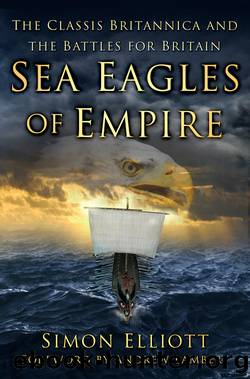Sea Eagles of Empire: The Classis Britannica and the Battles for Britain by Simon Elliott & Andrew Lambert

Author:Simon Elliott & Andrew Lambert [Elliott, Simon & Lambert, Andrew]
Language: eng
Format: epub
Tags: history, Ancient, Rome, Military, General
ISBN: 9780750969314
Google: yoITDQAAQBAJ
Publisher: The History Press
Published: 2016-08-03T00:14:45.534523+00:00
Given the size of the operation, it is unlikely that a single location can be identified for the Roman landings. More probably, the ships landed where they could, in the network of harbours, beaches and trading ports on the east and western sides of the Wantsum and troops secured themselves, by units, over a wide area.
Wherever the specific landing places were in north-eastern Kent for this invasion, the locale for the event was later commemorated by the building in the reign of Domitian of the monumental arch at Richborough detailed in Chapter 1 that stood from the late first century through to the late third century, latterly being used as a signal station (Strong, 1968, 72).
It is useful at this point to reflect on the military roles that were fulfilled by the new fleet during the initial phases of the Claudian invasion. In the first instance, control of the blue water environment in the oceanic zone of the North Sea and off the southern coast of Britain into the Atlantic is a given. Without this control, any sea crossing on this scale would have been unthinkable (a recurring theme throughout British history of course). As none of our primary sources speak of any native British naval presence of any size it seems reasonable to make the assumption this was lacking, and it is therefore also clear the Roman naval forces had complete control of the coastal littoral zone on both sides of the English Channel between which the three invasion waves travelled. Throughout the entire crossing one can also be sure that the war galleys (many by this time bireme liburnae with a few older models of bireme and trireme rather than the larger polyremes of Caesarâs incursions), myoparo and scapha of the fleet fulfilled an intelligence gathering and patrol function while protecting the flanks of the transport waves.
Clearly, however, the principal military role of the fleet would have been that of transporting this huge army and its stores safely across the English Channel and placing it ashore in Kent. From that point, given the invasion would have taken place in the midâlate summer months, the ships would then have carried out a supply function, transiting to and fro between the east Kent coast and the region around Boulogne (a maritime route that would become one of the busiest in the entire Empire once Britain officially became a province). Finally, the new fleet would have provided a vital communications function to keep the Imperial leadership, military and Roman populace informed as the conquest progressed.
With his forces and provisions building up ashore, but no enemy as yet to engage, Plautius next built an extensive ditch and bank fortification to protect his principal beachhead in Kent at Richborough, this clearly identifying the location as the hub of the various regional invasion sites. Still visible in places today, more than 640m of the defences have been excavated, with the overall site likely to have been rectangular in outline and enclosing a massive 57ha.
Download
This site does not store any files on its server. We only index and link to content provided by other sites. Please contact the content providers to delete copyright contents if any and email us, we'll remove relevant links or contents immediately.
| Africa | Americas |
| Arctic & Antarctica | Asia |
| Australia & Oceania | Europe |
| Middle East | Russia |
| United States | World |
| Ancient Civilizations | Military |
| Historical Study & Educational Resources |
Machine Learning at Scale with H2O by Gregory Keys | David Whiting(3633)
Never by Ken Follett(3528)
Fairy Tale by Stephen King(2950)
The Man Who Died Twice by Richard Osman(2808)
Oathbringer (The Stormlight Archive, Book 3) by Brandon Sanderson(2633)
Will by Will Smith(2580)
Rationality by Steven Pinker(2149)
The Dark Hours by Michael Connelly(2078)
The Dawn of Everything: A New History of Humanity by David Graeber & David Wengrow(2017)
Can't Hurt Me: Master Your Mind and Defy the Odds - Clean Edition by David Goggins(2004)
Friends, Lovers, and the Big Terrible Thing by Matthew Perry(1994)
Principles for Dealing With the Changing World Order: Why Nations Succeed and Fail by Ray Dalio(1894)
HBR's 10 Must Reads 2022 by Harvard Business Review(1697)
A Short History of War by Jeremy Black(1669)
Go Tell the Bees That I Am Gone by Diana Gabaldon(1600)
515945210 by Unknown(1520)
443319537 by Unknown(1395)
Kingdom of Ash by Maas Sarah J(1389)
A Game of Thrones (The Illustrated Edition) by George R. R. Martin(1368)
